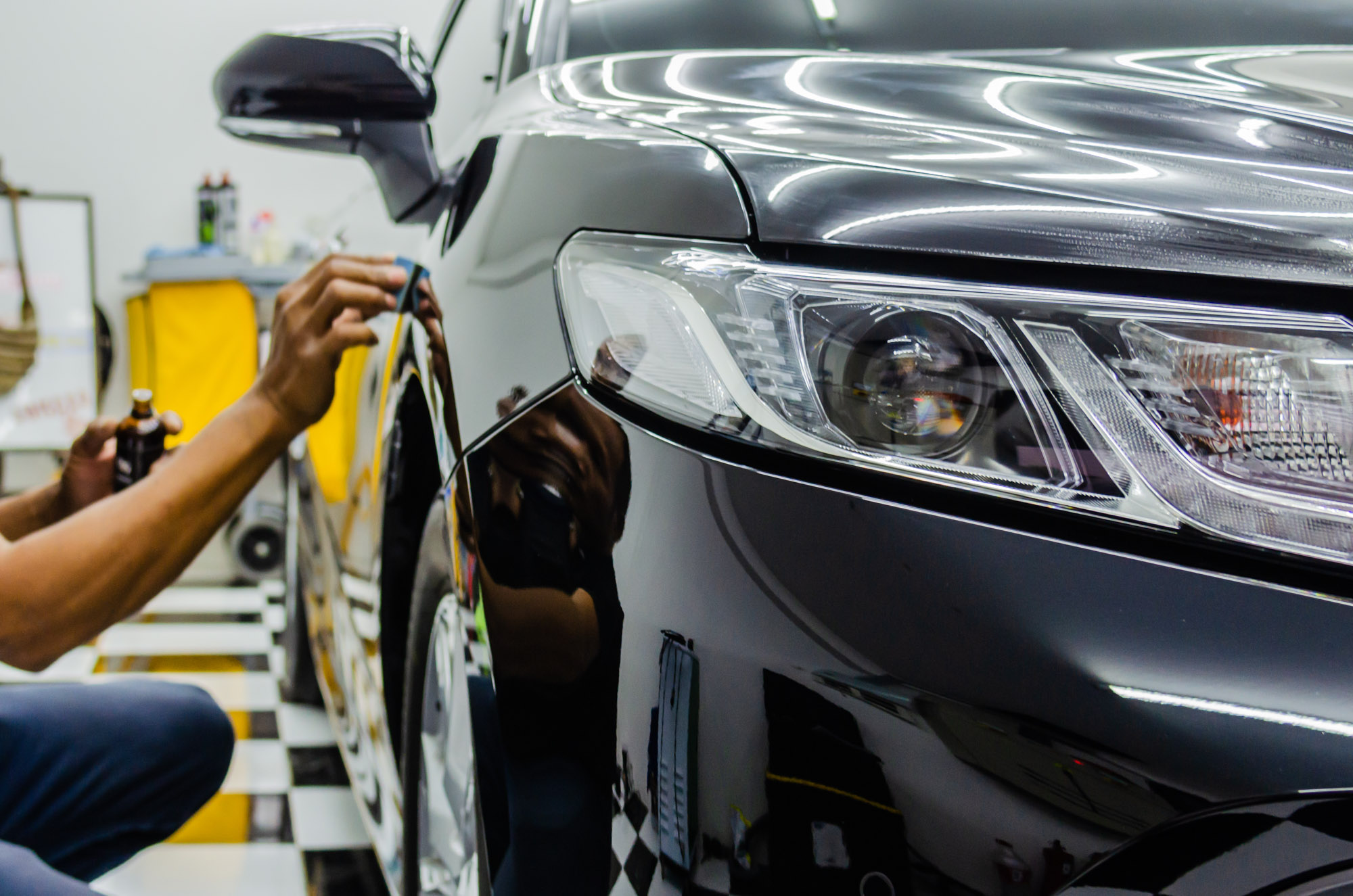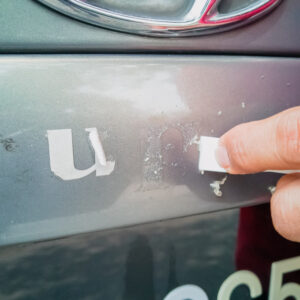Paint scuffs are surface-level imperfections caused by contact between the area and different objects. For cars, scuffs can happen when bumping into other vehicles, trashcans, shoes, and other things. Paint scuffs aren’t as deep nor as troublesome as scratches, making them easier to remove.
Paint Scuffs vs. Scratches
While scuffs and scratches are both surface damage, they differ in appearance and how they affect a vehicle’s paint job.
Scuffs
- Appearance: Scuffs, or paint transfer, are superficial because they affect only the top of the clear coat. They sometimes result in having paint transferred to the vehicle’s clear coat.
- Depth: Scuffs don’t leave that deep of a mark, unlike scratches.
- Removal: You can remove scuffs using wax or WD-40.
Scratches
- Appearance: Scratches are lines or gouges that cut into a car’s surface. They’re more visible than scuffs.
- Depth: Scratches are deeper than scruffs, penetrating the clear coat. Severe scratches typically require repainting a part of your car’s panel.
- Removal: For scratches, you’ll have to remove the clear coat before filling it up. That’s why it’s best to leave scratch repairs to professionals.
How to Remove Paint Scuffs From Car
There are different methods to remove paint scuffs from your car. You can go the easy route and use WD-40 or buff it out for a cleaner finish.
With WD-40
To remove paint scuffs with WD-40, you’ll first need the following items:
- WD-40 (Multi-Use)
- Soft sponge or cloth
- Gloves
Once you have everything, follow the steps below:
- Step 1: Spray the WD-40 onto the affected area.
- Step 2: Use the sponge or cloth to wipe away any excess product.
- Step 3: Repeat the process until the area is clean.
WD-40 is a handy product to have in your garage because you can use it for different applications, such as lubrication, degreasing, as well as rust and sticker removal. It also helps remove paint scuff marks because it saturates, softens, and lubricates the paint to make it easier to remove.
Do note that you shouldn’t use WD-40 on a car with matte paint, as aggressive rubbing can ruin its finish.
Buffing Out Paint Scuffs
Car buffing helps remove deep scratches and other imperfections from the car’s paintwork. It also works well with scruffs, resulting in a cleaner-looking finish. To buff out the paint scuffs on your car, you’ll need the following items on hand:
- Car washing product
- Paint cleaner
- Microfiber cloth
- Adhesive removers (that are safe for paint and coated surfaces)
- Polishing compound
- Buffing pad
Afterward, follow the steps below:
- Step 1: Gently rub the area with your fingernail to assess the damage. Sand the area if the scratches are deep. Otherwise, you can use adhesive remover to get rid of the shallow marks.
- Step 2: Use the car wash product to remove dust and dirt from the area.
- Step 3: Apply the cleaner using a microfiber cloth to remove old wax and grime. It’ll help clear paint that might have been transferred during the scuffing action.
- Step 4: Apply adhesive remover on scuff marks and stains. Turpentine or denatured alcohol works as an alternative.
- Step 5: Apply a polishing compound using a buffing pad, then clean the surface with a clean cloth.
How to Prevent Paint Scuffs

Paint scuffs are minor marks, and you can easily prevent them with good habits and proper protection. To prevent them, it’s best to park wisely, use ceramic coating, car covers, paint protection film, and paint sealant.
Park Wisely
As mentioned, scuffs are usually caused by minor collisions or bumps. This means you’re more susceptible when the car is moving, especially in tight spaces.
Whether you’re in a crowded parking lot or your spacious driveway, be careful when parking your vehicle. Take your time or use accessories to aid parking, like blind spot mirrors or back up cameras.
Use Ceramic Coating
Consider getting a ceramic coating. They’re hydrophobic, which means they give vehicles more protection against water, UV radiation, chemicals, extreme temperature conditions, dust, dirt, grime, moisture, and scratches.
The coating also locks up the car’s paint, making it immune to oxidation. It can last up to two years, making it a cost-efficient purchase.
Use Car Covers
Paint transfer won’t always happen when you’re the one driving your car. Sometimes, another object or vehicle could hit yours, causing scuffing. You can expect this to happen more frequently in tight parking lots, where the odds of one car hitting another are high.
Car covers can help protect your vehicle from dirt and scuffs. They’re easy to put on and inexpensive. For as low as $125, you can get a brand-new cover that will prevent more expensive repairs and cleaning in the long run.
Use Paint Protection Film
Car paint protection acts as another protective layer on top of your vehicle. It prevents scuffs, scratches, swirl marks, and other minor damage.
Protection films also don’t mess up a vehicle’s aesthetics due to its clear color. In addition, it preserves the car’s resale value, prevents color fading, and lasts up to 10 years.
Use Paint Sealant
Paint sealant is a hydrophobic synthetic product you can apply at home. It forms a barrier that protects the paint from dirt, brake dust, and other contaminants.
DIY-friendly paint sealants typically last a year and can be sprayed directly on the vehicle. Your sealant of choice should have detailed instructions on proper application.
Get a High-Quality Car Cover for Your Vehicle
Paint scuffs might not seem like a big deal, but keeping your car paint in good condition is important if you plan on reselling your vehicle. Scratches can lower your car’s resale value. Because paint also acts as a protective layer, chips and scuffs leave your vehicle’s exterior open to further damage. Luckily, you can avoid all that by investing in a car cover. Prevent future paint scuffs by getting a high-quality car cover from CarParts.com today.
At CarParts.com, you can get a brand-new car cover for your vehicle with just a few clicks. Enjoy a hassle-free transaction thanks to our easy-to-navigate website. We’ve also included a search filter feature that lets you easily browse through the products that are compatible with your ride. If you’re unsatisfied with your order, you can return your car cover and receive a refund as long as it falls within our 60-day return policy.
Don’t wait until your vehicle’s paint gets scratched before investing in a car cover. Check out our catalog of high-quality car covers at CarParts.com and order one today!
Any information provided on this Website is for informational purposes only and is not intended to replace consultation with a professional mechanic. The accuracy and timeliness of the information may change from the time of publication.



































